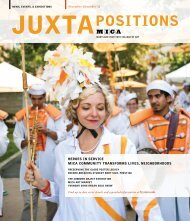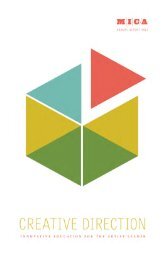art/vision/voice - Maryland Institute College of Art
art/vision/voice - Maryland Institute College of Art
art/vision/voice - Maryland Institute College of Art
Create successful ePaper yourself
Turn your PDF publications into a flip-book with our unique Google optimized e-Paper software.
126 <strong>art</strong> / <strong>vision</strong> / <strong>voice</strong><br />
It can be argued that anything that gives<br />
legitimacy to the field is probably a good thing.<br />
The more it’s written about and explored<br />
critically, the more it’s going to develop into<br />
something that will change the nature <strong>of</strong> <strong>art</strong><br />
making and have an impact on the contemporary<br />
<strong>art</strong> world as well. The idea <strong>of</strong> these parallel<br />
universes in the <strong>art</strong> world became very<br />
apparent in the 1980s when organizations<br />
and groupings <strong>of</strong> <strong>art</strong>ists based on race or<br />
gender created their own work, which then<br />
filtered upwards into the mainstream <strong>art</strong><br />
world. Perhaps that’s always been the cycle,<br />
but it would be nice to think we could change<br />
the way culture is made in this country.<br />
In reading the case narratives <strong>of</strong> Mary<br />
Valverde, Leslie Hewitt, and Antoine Touze, I<br />
was struck by their instincts and their intuition<br />
about what makes a real collaboration work. It<br />
took much longer for me to learn from my<br />
mistakes—and I made a lot <strong>of</strong> them. All three,<br />
Mary, Leslie, and Antoine, were involved with<br />
Cooper’s Saturday Program, which probably<br />
made a big difference. They learned early in<br />
their careers that peer teaching is a huge p<strong>art</strong> <strong>of</strong><br />
community <strong>art</strong> making.<br />
Whenever I collaborate with the community,<br />
I feel I’m going to learn something and that<br />
my collaborators and I are peers. To assume I’m<br />
going to control what happens is arrogant—<br />
there has to be mutual respect as well as room<br />
to listen to what other people have to say.<br />
That isn’t as easy as it seems because teaching<br />
is really about sharing knowledge. So many <strong>of</strong><br />
the young people I worked with were so<br />
damaged by the school system that they really<br />
did not want to be told how to do something.<br />
And yet they had no skills, so it was a juggling<br />
act — trying to understand how to<br />
communicate, how to teach without imposing<br />
something on people they felt uncomfortable<br />
with. Some <strong>of</strong> the teenagers I worked with<br />
in youth programs actually went to court in<br />
the morning then came back, or had attention<br />
problems so they really couldn’t sit in a<br />
structured situation for very long.<br />
When we were painting community murals,<br />
in order to teach and engage the young people,<br />
we had to be creative. We used Polaroid<br />
cameras and slides, had people role-playing in<br />
the streets, and we relied heavily on oral history<br />
and sketching in the scenarios we developed in<br />
the workshops. We didn’t have Barnes & Noble<br />
stores in those days, and many kids didn’t even<br />
have books in their homes, so we had to ask<br />
them to tell their own stories by relying on<br />
family and neighborhood histories.<br />
If there is anything to learn from the Queens<br />
project, it is that attention to process is one<br />
<strong>of</strong> the things overlooked or not emphasized<br />
enough in the field <strong>of</strong> community <strong>art</strong>s. The<br />
process <strong>of</strong> how one gets to the point <strong>of</strong><br />
making <strong>art</strong> is not just the <strong>art</strong> workshops<br />
themselves, but all the planning that precedes<br />
them, all the discussions between <strong>art</strong>ists and<br />
community that bring them to some form <strong>of</strong><br />
agreement about what it is they want to do.<br />
And that process gets shortchanged when it’s<br />
created months in advance <strong>of</strong> actually meeting<br />
the community—or if the same handful <strong>of</strong><br />
<strong>art</strong>ists are continually approached by community<br />
groups because they have a model project that<br />
can be applied indiscriminately to any<br />
neighborhood. The process gets shortchanged<br />
when people don’t realize that dialogue is<br />
sometimes very contentious, so their fear <strong>of</strong><br />
confrontation leads to censorship. It’s not an<br />
easy process, because there are people who are<br />
not always happy to have community <strong>art</strong>s—they<br />
don’t know what it is. They’re threatened by it. I<br />
see that there’s a need for advocacy and a need<br />
for people to take risks. Administrators have to<br />
meet the <strong>art</strong>ist halfway and sometimes that<br />
dialogue is not smooth. That’s all a p<strong>art</strong> <strong>of</strong> the<br />
collaborative process —the planning, discussion,<br />
and dialogue that has to be seen as long term. In
















